|
|
|
|
|
|
'Mini facts III'
The Mini has been produced in countries like Portugal, Australia, New Zealand, Italy, Spain, Belgium, South Africa, Chile and Venezuela. But it's spiritual home was Longbridge in the West Midlands (UK), where it remained in constant production for over 41 years. 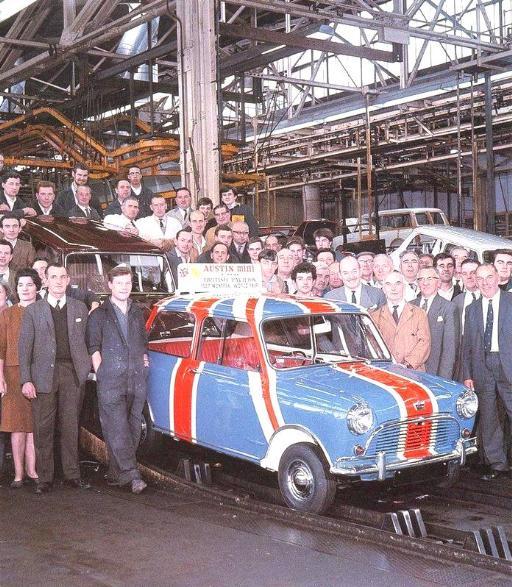 One of the more improbable claims that have been made for the Mini was that it caused the
collapse of the British Motor-Cycle Industry. One of the more improbable claims that have been made for the Mini was that it caused the
collapse of the British Motor-Cycle Industry. 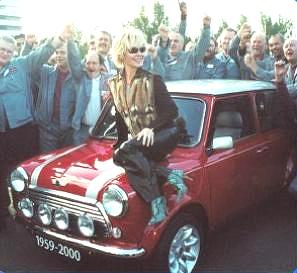 The record for a Mini Cram was 26. The event happened on the Noel Edmunds Late Late Breakfast Show. The legendary Mini was voted 'the greatest car of all time' by Autocar & Motor Magazine in March 1991. It is believed that more British people have either learned to drive in or had a Mini as their first car than any other car. The Mini is still one of the shortest production cars at fractionally over 10 feet long and inspired the 'short vehicle' sticker. The Mini is a motoring legend and has been in production during the 50's, 60's, 70's, 80's, 90's and into the 21st century - effectively 6 decades. The Mini has been in production for well over a third of the entire history of the UK motor industry, which had its centenary in 1996. In 1997 Rover Cars produced a 160bhp Mini capable of 0-60 mph in less than five seconds. If you laid all the Minis ever made end to end, they would stretch from London to Sydney, Australia. The Mini was one of the most the most unique and revolutionary cars ever made and it's also true to say that it exceeded well beyond all expectations, but many claim that it never made an honest profit in it's life. The final production number of Minis produced is 5,387,862.
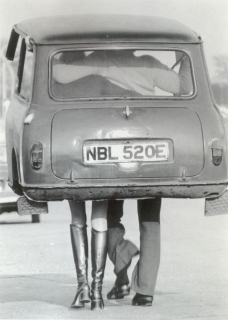
Mini timesTo most people, the basic shape of the Mini appeared unchanged, although it did evolve and was even developed with many useful variations added to the range during it's 41 years of production. Although on many occasions it faced the axe, the car always seemed to survive against all the odds and even make a big come back. What's amazing is how the car survived so long, especially when it's considered that it never made a substantial profit and as such, some even blame it's success for the decline of the British Motor Corporation. Below is a brief run through of the changes that affected the Mini, in the course of its production life.
The 60’s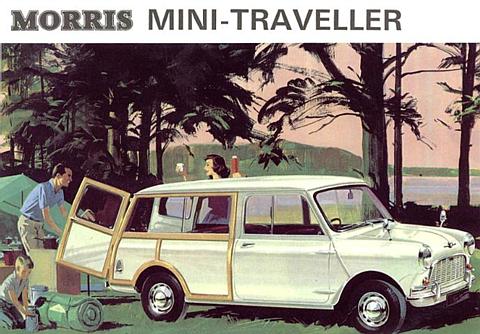 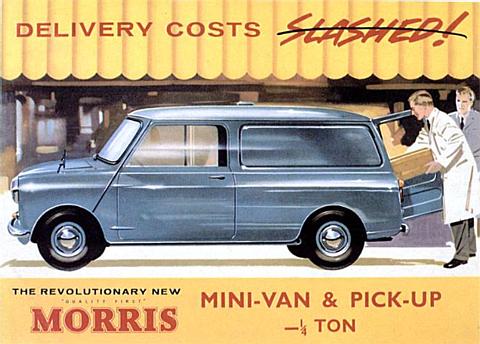 If any production car lent it-self to being adapted, it had to be the Mini. With the drive train neatly packaged at the front in its own sub-frame it could be stretched, adorned and stripped, hence the variations that took the Mini concept to its limits. As soon as the car was launched, it wasn’t long before there was a Mini for every job and eventuality. Firstly, came a commercial vehicle, in January 1960 the Mini Van was launched, then in September 1960, after it's success, windows were installed in the Van body-work and the Mini Estate versions were born. More upmarket versions of the Mini Estate even got the wood trim similar to that fitted to the Morris Minor Traveller, but it was not structural on the Mini models. Then in February 1961 another commercial vehicle, the
Mini Pick-up was launched, this was identical to the van except for the missing roof and
side panels. But it also had van-like versatility because an optional (later Next up, in October 1961 the Riley Elf and Wolseley Hornet arrived. These were pocket-sized Rolls Royce’s, but not only did their interiors resemble the smallest room in a stately home, with their leather-like seats and upmarket dashboards (full width walnut on the Elf), BMC also gave the cars distinctive body styles too. At the back there were little fins and a larger boot, up front there was an upright grille amongst other upmarket fixtures. These were also the first Mini models to later receive wind-up windows and concealed door hinges. Also at the same time as the Riley Elf and Wolseley Hornet, thanks to the insight of racing car constructor John Cooper of the Cooper Car Company Ltd, the legendary Mini Cooper was launched, with it's performance engine, snappy remote gear change and up-rated disc brakes it was immensely successful and from 1963, with the birth of the giant killing Mini Cooper S, it was unbeatable and brought home all the trophies in all forms of motor-sport, including 4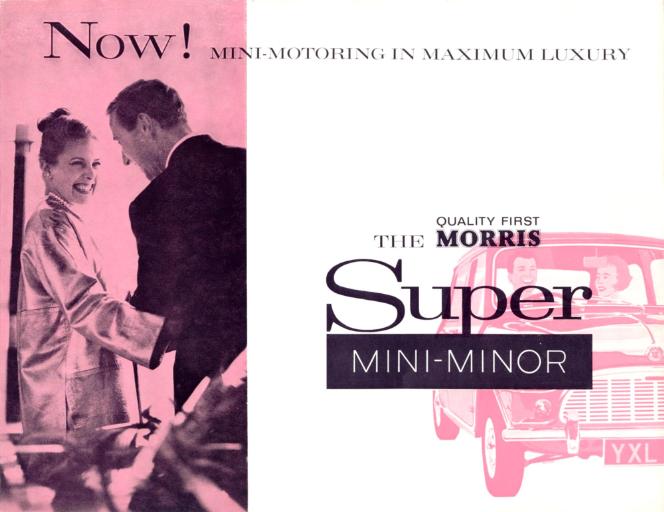 outright wins on the famous Monte Carlo Rally.
This was the model that proved just how effective the Mini concept was to the initial sceptics and no doubt saw the outright wins on the famous Monte Carlo Rally.
This was the model that proved just how effective the Mini concept was to the initial sceptics and no doubt saw the whole range become a major sales success as a result. The Mini Cooper could easily Then there was also the Mini Moke, this started out as a
stab at military application. The idea was that as every
armed force in the world wanted a vehicle sturdy enough to withstand a parachute drop,
light enough to be lifted by a small helicopter and which could be packed flat and stored
one on top of another, the As the 1960’s moved on, so the Mini had been refined
with better brakes and an improved baulk ring syncromesh transmission. Then in
September 1964 all saloon models were equipped with (Alex Moulton) hydrolastic suspension,
which was then the state of the art suspension system. This used At the
end of the 1960's, there was much speculation that the Mini from day one had been
under-priced and as a result wasn't making any real profit. In fact, when the Mini
was first launched, Ford who like all other manufacturers, had In 1968, BMC merged with the Leyland truck makers to form BLMC or British Leyland as it was commonly known. As a result and with no money to launch a completely new small car range, bigger changes to the Mini lay ahead.
The 70’s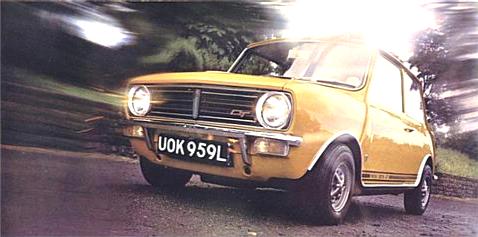
The Mini range had already been successfully updated, becoming Mark II in 1967, but with British Leyland as its new owners, the Mini was forced to evolve once again. Firstly in 1969, the Riley Elf, Wolseley Hornet, Mini Countryman/Traveller Estates and Mini Cooper models were all discontinued, then the Mini was given a radical face-lift and got a longer, more square front end and updated interior for the Mini Clubman range which British Leyland initially marketed as "The Big Happening". There was a saloon (with all the new Clubman features), an estate (which was the same basic shape as the earlier estate models, only with the Clubman front and radically updated interior and trim) and sporty 1275GT (originally marketed as a replacement for the smaller engined Cooper, it had all the right features including for the fist time in a Mini, a tachometer) that were, like the out-going Riley Elf and Wolseley Hornet, fitted with wind-up windows and concealed door hinges and they proved as effective sellers as the models that had gone before. 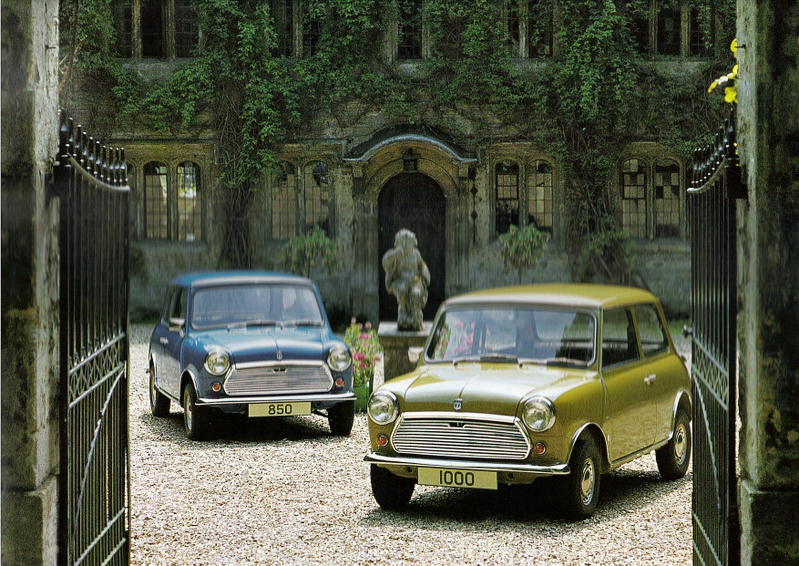
Unfortunately many motoring journals and books over the years, have given the Clubman range a lot of criticism, mainly blaming the 1275GT for the demise of the Cooper and later the Cooper S during 1971 too. But Donald Stokes the then chairman of British Leyland was really to blame because he had no rapport with John Cooper or any interest in motor racing and he didn't believe it had any effect on car sales either even though it had without a doubt helped make the Mini a great success. But then he had made the Mini Cooper S redundant in 1970 anyway when he closed the legendary Works Department at Abingdon. Still even old Stokes couldn't put the brakes on the lavishly equipped Italian built Innocenti Mini Cooper and the Spanish built Authi Mini Cooper that continued in production for another several years longer. Anyway, the Clubmans are true Minis through and through and although some purists are no fans, they now have a following of their own, are appreciated by most Mini enthusiasts and are well worth restoring. 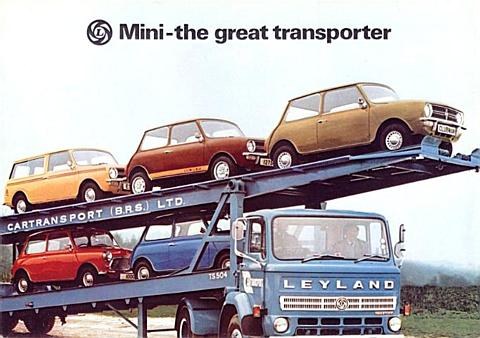
But despite all the change, the Minis traditional front was still available and from late 1969, they then for the first ever came time with wind-up windows and concealed door hinges in the form of the Mini 850 & Mini 1000. The Mini 850 & Mini 1000 models were not fitted with hydrolastic suspension, instead they reverted back to the original rubber suspension system, as did the Clubman range during 1971, with the Mini Cooper S also briefly updated to Mark III spec during early 1970 being the last Mini to feature hydrolastic suspension before it was axed in July 1971. There were no other major changes for the Mini during the 70's, apart from slight revisions and refinements being applied, like from 1974 when the Mini 1275GT became the first Mini to feature 12" wheels and larger disc brakes (something all Mini's would benefit from during the mid-eighties) and later it also featured the revolutionary but short lived Dunlop Denovo run flat tyres, that would instantly inflate themselves with fluid in the event of a puncture, so saved all the hassle of carrying and using a spare. From 1975 the Clubman saloon and estate got the 1098cc engine and then from 1976, Mini subframes became rubber mounted and all cars featured new controls, switchgear and once again updated trim. Soon and for the first time, Mini grilles became matt black instead of chrome, the seats resembled deck-chair covers and with all the hype from British Leyland on the soon to be announced, so called replacement Mini, the "MiniMetro", the Mini range was thought to be nearing the end of it's natural life.
The 80’s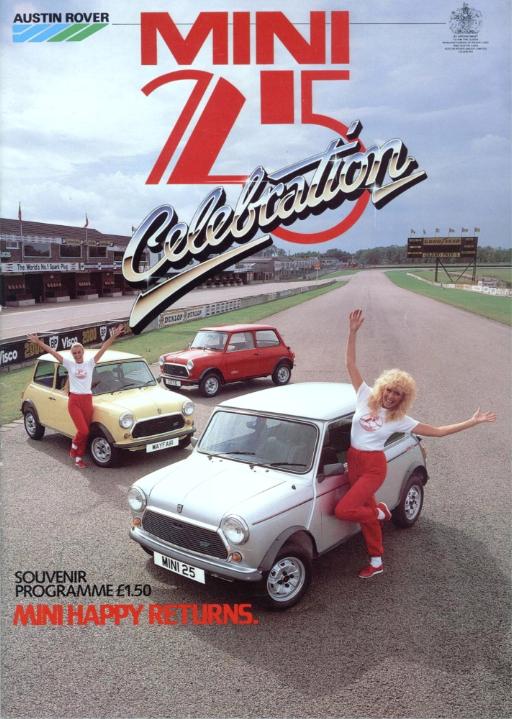 British Leyland was now known as Austin Rover
and after the company had launched it's own small hatchback, the future of the Mini was in
doubt. For a start, at the end of 1980, the Clubman range was discontinued,
with just the Estate version remaining, but now badged as the HL Estate and like all the But thanks to fresh thinking from new management at Rover and a phenomenal
cult following from Japan this didn't happen. So Rover then chose to raise it's profile via a well remembered and successful 1986/87 Christmas television advertising campaign
titled "Minis Have Feelings Too" that no doubt helped see sales increase in the UK. Then in 1989 after a massive turn-out of Mini enthusiasts for the Mini's 30th
birthday celebrations at Silverstone and the success of a top of the range, luxury Mini 30 limited edition model (which amongst other things, helped Also that same year and for the first time in quite some time, Rover acknowledged the Minis Motorsport heritage
by launching a range of sporty limited edition Minis that
The 90’s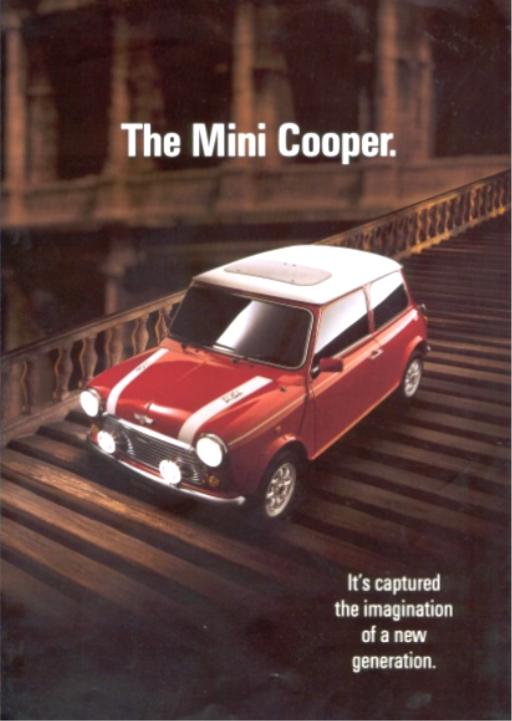 So rather than being allowed to just quietly fade
away, the Mini was given a new lease of life during the 1990's. Right at the start of the decade, Rover released a second wave of Mini Cooper inspired Racing Green and Flame Red LE's that
were joined this time by a black/white duo-tone model called the Check Mate and Due to new regulations a considerable sum of money was later spent to bring the car's up to current safety legislation and the latter models, from late 1996 now marketed as Mini and Mini Cooper, plus the occasional top spec limited edition, featured a drivers air-bag, side-impact bars and seat belt pre-tensioners, not to mention tastefully uprated trim and fittings, plus quieter running at motorway speeds thanks to extra sound deadening, higher gearing and for the first time ever, a front mounted radiator and electric fan. Thus making these the best equipped and most lavish Minis yet and they were offered with unlimited optional accessories from both Rover and John Cooper Garages. Time did eventually catch up with the Mini, but the final 500 Mini Cooper Sports off the production line are held in very high regard and some owners have even added little 500 stickers to highlight their status.
Now & the future
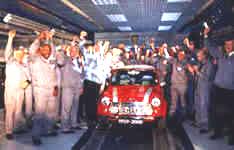 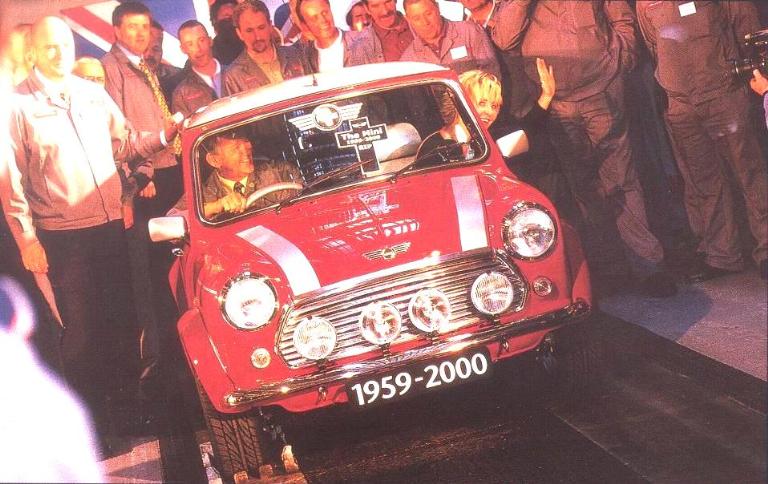 Sadly, on the 4th October 2000
with 5,387,862 cars produced, Mini production ended. Mini enthusiasts had known for
many years that production was due to end that year, but it was still hard to accept that
time had caught up with the Mini and the production line at Longbridge would finally come
to rest after over 41 years.
Sadly, on the 4th October 2000
with 5,387,862 cars produced, Mini production ended. Mini enthusiasts had known for
many years that production was due to end that year, but it was still hard to accept that
time had caught up with the Mini and the production line at Longbridge would finally come
to rest after over 41 years.
Later that same day, many Mini enthusiasts belonging to different Mini clubs around the country took part in funeral processions through their villages, towns and cities as a mark of respect and sadness that their favourite car, the car of the 20th century had ended production. 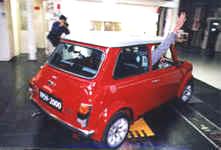 The good news is that the classic Mini will still be
available second hand for years to come and thanks to the British Motor Heritage and all the
other Mini specialists around the world,
Mini linksAfter you've thoroughly viewed my site via the 4 navigational buttons above, why not check out these links that are listed below, because a few are for UK & Ireland based Mini Forums that will provide (amongst other things) detailed information and help on buying a Mini, whilst the other links are for websites that provide more specialised Mini related information: - Anyway for a kick off here's links to several fantastic on-line Mini-Clubs/Forums and The Mini Forum
is one of Well there's a few Mini Forums to choose from, but here's a fantastic site called WorksMini.com (which provides all the facts and images on the famous giant killing and world beating ex-Works Mini Coopers). For classic film buffs you will find a site offering Mini downloads, amazing images and information concerning the 1969 classic comedy crime caper movie The Italian Job (the film that immortalised the Mini forever) and here's also links to Mini Magazine & Mini World Magazine web sites (the 2 main UK monthly magazines for Minis). Here's also a link to Austin Rover Online where you will find some information which may be of interest concerning the rare overseas built Minis. The title may have changed, but it is still an "Unofficial" site and there is plenty of interesting information and images there to browse through.
Last Mini videoHere's a link from my YouTube account of the BBC1 & ITV afternoon TV coverage of the last Mini rolling off the famous Longbridge Mini production line on the 4th October 2000 at around 9.30am So just hit the play button to view: -
Mini Conclusion Like I said in the introduction on my home page, the Mini was voted by some motoring journals as the car of the twentieth century and by others as the greatest car of all time. It has also been called one of the greatest inventions of all time and one of the most important British cars ever designed. But even though Issigonis showed the world how to effectively package a car and it then exceeded beyond all expectations, some still blame it for the decline of the British Motor Industry. The fact it was under priced and it never made an honest profit in it's life is always brought up, but it is absolutely ludicrous to say that the demise of Rover is down to Alec Issigonis and his innovative creations. Even Alex Moulton the Minis suspension designer stated in a recent radio interview that the company was in profit during the 1960's and it was the bad things that occurred later on from the endless industrial action of the 1970's to the bland range of cars that didn't catch the public's attention that was really to blame. World production figures and sales also prove that it was just as successful during the 1970's as it had been during the 1960's, even though the endless industrial unrest wasn't helping matters at that time. It's also laughable how some so called motoring enthusiasts claim that "most small cars today have copied the Fiat formula of the transverse-engined, end-on gearbox package", when before the Mini proved it's point, Fiat were happily stuffing the engines into the rear of their cars and then there's the fact that even their own chief designer (who had designed cars like the original Fiat 500) is said to have written in his memoirs how he regretted not coming up with the Mini concept first. With all the attention, ever growing interest, enthusiasm and the value of classic Minis forever rising, I'd say that there's a lot of envy and spite being shown and just a little sour grapes too from many other motor enthusiasts. But whatever you think, the Mini was considered to be a good little earner during it's latter years and as a result remained in full production for over 41 years and it was far more of a success around the world than the so called Mini Metro ever was. The Mini also went on to become Rovers greatest export model during the 1990's and created more goodwill towards BMC, British Leyland, Austin Rover and Rover than any other car. So as a nation should we be proud of the original Alec Issigonis classic Mini? Well surely only a fool wouldn't be.
The Car's The StarFinally here's my YouTube video's of 'The Car's The Star' which was the Top Gear spin off TV show (written & presented by Quentin Willson) that featured the great British Mini in this particular episode which was first shown on BBC2 in 1997: -
|